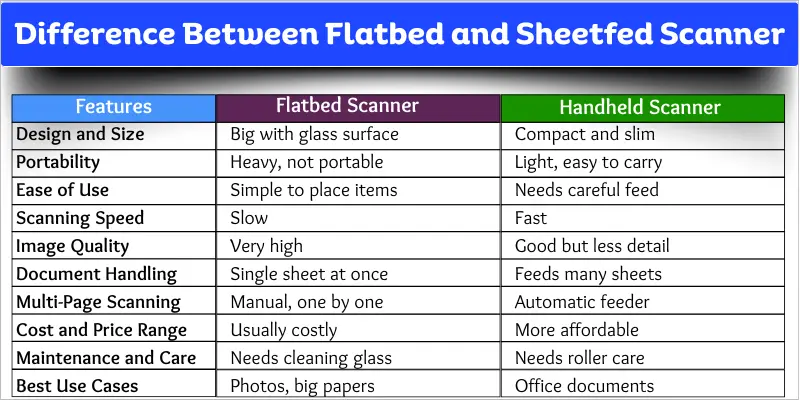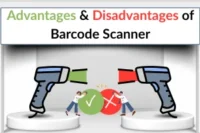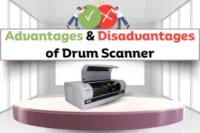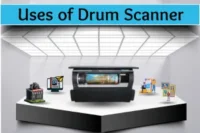Difference Between Flatbed and Sheetfed Scanner – Explained Simply
Published: 3 Oct 2025
Are you confused about the difference between flatbed and sheetfed scanner? Don’t worry, you’re not alone. Many beginners find it hard to choose the right scanner. Flatbed scanners focus on quality and single-page use, while sheetfed scanners save time with many pages. Here we will explain the differences in a very simple way, so you can decide which one fits your needs best.

Difference Between Flatbed and Sheetfed Scanners
Flatbed and sheetfed scanners both help you scan documents. But they work in different ways. Each has its own advantages and limits. Knowing these differences helps you choose the right scanner for your needs.
Here are the 10 main differences:
- Design and Size
- Portability
- Ease of Use
- Scanning Speed
- Image Quality
- Document Handling
- Multi-Page Scanning
- Cost and Price Range
- Maintenance and Care
- Best Use Cases
Let’s understand each difference of flatbed vs sheetfed scanners.
Design and Size
Design and size tell us how a scanner looks and how big it is. Flatbed and sheetfed scanners are very different in shape and size.
Flatbed Scanner
Flatbed scanners are usually large and flat. You place documents on the glass for scanning. Their design is stable and good for home or office use. They take more space but give high-quality scans.
Sheetfed Scanner
Sheetfed scanners are smaller and upright. You feed papers into the slot one by one. They save space and are easy to carry. Their design is simple and fits small desks or offices.
Portability
How easy a scanner is to move matters for many users. Let’s compare the portability of both types.
Flatbed Scanner
These flatbed scanner types stay in one place because they are large and heavy. You need a table or desk to use them. Moving them around is not easy. They suit offices or homes where the scanner does not need to travel.
Sheetfed Scanner
These types of scanners are light and easy to carry. You can take it to meetings, classrooms, or different rooms. These works well for users who need scanning on the go. Sheetfed scanners fit small spaces and travel easily.
Ease of Use
Using a scanner should be simple, especially for beginners. Flatbed and Sheetfed scanners work differently, so ease of use matters.
Flatbed Scanner
Operating a Flatbed scanner is very simple. You just place the paper or photo on the glass and press the scan button. The scanner does the rest automatically. Flatbed scanners are great for beginners who want stable and clear results without much effort.
Sheetfed Scanner
Sheetfed scanners need a little practice to use well. You feed the document into the machine, and it pulls the page through automatically. They are faster for multiple pages but require careful alignment. Sheetfed scanners suit users who scan papers quickly and don’t mind handling the feed.
Scanning Speed
Speed is important when you have many documents to scan. Flatbed and Sheetfed scanners differ in how fast they work.
Flatbed Scanner
A Flatbed scanner scans slowly because it moves line by line over the document. It gives very clear and detailed results. Flatbed scanners work best when quality is more important than speed.
Sheetfed Scanner
Sheetfed scanners scan faster because they pull the paper through automatically. They can handle multiple pages quickly without stopping. Sheetfed scanners are perfect for offices or situations where you need speed.
Image Quality
Good image quality is important for clear scans. Flatbed and Sheetfed scanners give different results.
Flatbed Scanner
Flatbed scanners give very sharp and detailed images. They capture photos, charts, and documents with high clarity. Flatbed scanners are ideal when you need accurate colors and details.
Sheetfed Scanner
Sheetfed scanners produce decent image quality but may be less detailed than a flatbed. They focus more on speed than perfection. Sheetfed scanners are great for everyday office documents.
Document Handling
Handling documents correctly is key for smooth scanning. Flatbed and Sheetfed scanners manage papers differently.
Flatbed Scanner
Flatbed scanners let you scan single sheets, books, or thick papers easily. You place the document on the glass and start scanning. Flatbed scanners work well for delicate or large pages. They are perfect when you need careful handling.
Sheetfed Scanner
Sheetfed scanners pull sheets automatically through the machine. They handle many pages quickly and save time. Sheetfed scanners work best for loose documents. They are not ideal for books or thick papers.
Multi-Page Scanning
Scanning many pages at once is important for busy work. Flatbed and Sheetfed scanners handle multiple pages in different ways.
Flatbed Scanner
Flatbed scanners scan one page at a time. You need to place each sheet on the glass. It takes more time for multiple pages. Flatbed scanners are better for detailed single-page scans.
Sheetfed Scanner
Sheetfed scanners can scan many pages automatically. You load a stack of sheets, and the scanner feeds them one by one. It saves time and works well for large documents. Sheetfed scanners are ideal for multi-page scanning tasks.
Cost and Price Range
Knowing the price helps you choose the right scanner for your budget. Flatbed and Sheetfed scanners differ in cost.
Flatbed Scanner
Flatbed scanners usually cost more. They provide high-quality scans and handle large documents. Offices and professionals often buy them for detailed work. The price matches the features and reliability they offer.
Sheetfed Scanner
Sheetfed scanners are generally cheaper. They are good for fast scanning of multiple pages. Students, small offices, and home users often choose them for budget-friendly tasks. Sheetfed scanners give value without high cost.
Maintenance and Care
Taking care of your scanner keeps it working well for a long time. Flatbed and Sheetfed scanners need different care.
Flatbed Scanner
Flatbed scanners are strong and easy to maintain. You only need to clean the glass surface sometimes. They have few moving parts, so repairs are rare. Flatbed scanners are reliable for long-term home or office use.
Sheetfed Scanner
Sheetfed scanners need a bit more attention. Paper jams can happen if you are not careful. Cleaning the rollers and scanner path often helps. Regular care keeps Sheetfed scanners working smoothly.
Best Use Cases
Knowing who should use each scanner helps you choose the right one. Flatbed and Sheetfed scanners work best in different situations.
Flatbed Scanner
Flatbed scanners are great for offices, schools, and home use. They scan photos, large documents, and official papers with high quality. Flatbed scanners are perfect when detail and accuracy matter more than speed. Professionals and students prefer them for careful scanning. You can read more about the uses of flatbed scanners to understand their benefits
Sheetfed Scanner
Sheetfed scanners suit businesses and people who scan many pages quickly. They handle multiple sheets fast and save time. Sheetfed scanners are ideal for offices, small shops, and regular document work. They are perfect when speed and efficiency are more important than scanning large photos.
Conclusion
So, friends, now let’s wrap up what we learned about the difference between flatbed and sheetfed scanners. Flatbed scanners work best for photos, books, and detailed documents. Sheetfed scanners are perfect for offices and scanning many pages fast. Always pick the scanner that suits your needs. Share this guide with others or comment below if you have questions!
FAQs about Flatbed vs Sheetfed Scanners
Here are some questions beginners often ask about flatbed and sheetfed scanners. We will answer them in a clear and easy way.
Some sheetfed scanners can scan both sides of a paper automatically. This feature is called duplex scanning. It saves time when you have double-sided documents. Not all models have it, so check before buying.
A flatbed scanner is used to scan single pages, photos, and books. It works well for detailed and high-quality scans. You place the item on the glass and press scan. Flatbed scanners are perfect when you need clear and accurate results.
Flatbed scanners scan one page at a time. You must place each sheet on the glass separately. Scanning many pages takes time. They are not ideal for large stacks, but perfect for photos or books.
An ADF is a feature in some scanners that feeds multiple pages automatically. It saves time because you don’t have to place each page manually. Sheetfed scanners usually have ADF. It is great for offices and multi-page documents.
Yes, flatbed scanners are best for photos. They capture fine details and colors accurately. You place the photo on the glass, and the scanner reads it carefully. Sheetfed scanners may lose small details. Flatbed is perfect for high-quality photo scanning.
Sheetfed scanners are not ideal for books. They can only scan loose pages. Feeding a book may damage it or cause paper jams. Flatbed scanners are safer for books. They let you scan pages without bending them.
Flatbed scanners handle thick papers easily. You just place the page or book on the glass. Sheetfed scanners may struggle with thick or uneven pages. Flatbed is better when you scan official papers, books, or magazines.
Fragile papers need careful scanning. Sheetfed scanners may tear delicate sheets if not handled properly. Flatbed scanners are safer because the paper stays flat. Use sheetfed scanners only for normal office documents.

- Be Respectful
- Stay Relevant
- Stay Positive
- True Feedback
- Encourage Discussion
- Avoid Spamming
- No Fake News
- Don't Copy-Paste
- No Personal Attacks

- Be Respectful
- Stay Relevant
- Stay Positive
- True Feedback
- Encourage Discussion
- Avoid Spamming
- No Fake News
- Don't Copy-Paste
- No Personal Attacks



